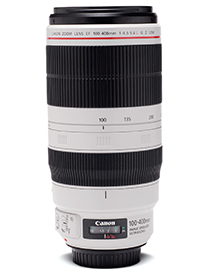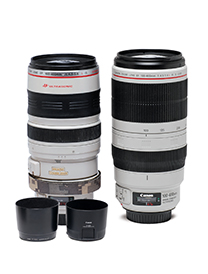 The very recently announced, much awaited highperformance super telephoto zoom from Canon is here. The new lens, like the earlier version, is designed for fullframe cameras but can be used on APS-C bodies. So what’s new with this lens? How does it perform? Read on…
The very recently announced, much awaited highperformance super telephoto zoom from Canon is here. The new lens, like the earlier version, is designed for fullframe cameras but can be used on APS-C bodies. So what’s new with this lens? How does it perform? Read on…
Design & Build Quality
Canon’s new 100-400mm lens is a twist-type zoom (the earlier version was a ‘push-pull’ design). Its outer body is made mostly from metal and the build quality is excellent. The lens comes with a metal collar which allows the camera body to be rotated in horizontal or vertical format when attached to a tripod. The tripod mount, attached to the lens collar, is removable. The filter thread appears to be made of metal. The lens weighs 1700 g with the lens collar and lens hood. Filter diameter is 77mm.
Key Features
Let’s first see the key similarities and differences between the new (EF100-400mm f/4.5-5.6L IS II USM ) and the older version (EF100-400mm f/4.5-5.6L IS USM) of the lens:

Highlighting indicates advantage
As you can see from the above, the new lens has definite advantages over the earlier version. The zoom ring in the front has a nice 42mm wide rubberised grip. The manual focus ring towards the camera body is also rubberised for a nice grip. The lens has a distance scale in feet and meters and has a margin at the infinity position – since infinity focus point can shift with changes in ambient temperature. The zoom ring is marked at 100, 135, 200, 300 and 400mm settings. At the left of the lens are four slider-type switches – from top to bottom, Focussing distance range selector, Focus mode switch, Image Stabilizer switch and Stabilizer mode switch. Between the zoom ring and the focussing ring, is a ‘Zoom-touch adjustment ring’ that allows the user to control how tight or how free the zooming action is.
The EF100-400mm f/4.5-5.6L IS II USM is equipped with a 3-mode Image Stabilzer (IS) that Canon claim to offer a 4-stop advantage (when the focal length is set to 400mm and when used with the Canon EOS 1DX). Mode 1 corrects for vibrations in all directions and is suitable for photographing ‘still’ subjects. Mode 2 can correct for vertical camera shake (updown movement) when the lens is moved horizontally, and correct horizontal camera shake (side-toside movement) when the lens is moved vertically. Mode 3 corrects for vibrations only during the actual exposure and is effective for shooting irregularly moving subjects. (In mode 1 and 2, you’ll see the image stabilized in the viewfinder when you press and hold the shutter button half-way). Note: The IS is active for about 2 seconds even after your finger is off the shutter release button. Hence you should wait for at least 2 seconds before detaching the lens from the camera body.
As mentioned in the table above, the new lens comprises of 21 elements in 16 groups. It includes fluorite and Super UD lens elements for superior` definition. A special lens coating known as ASC (Air Sphere Coating) is used to reduce flare and ghosting. Fluorine coating is also applied to the foremost and rearmost lens surfaces which allows adhered dirt to be removed easier than before.
The EF100-400mm f/4.5-5.6L IS II USM lens uses a Ultrasonic Motor (USM) for fast and quiet autofocus. During AF, manual focus override is possible after the subject comes into focus (ONE SHOT AF). The lens hood has a special design – a cut-out with a slider which allows the user to adjust the position of an attached circular polarising filter while the hood is attached to the lens. The hood can be inverted and attached to the lens during transit. The lens has a fixed metal collar but the foot that is attached to the collar, is removable. In my opinion, this is a questionable design since a loose foot could cause the lens to wobble on a tripod.
The lens is provided with seals for dustproof and drip-proof performance but Canon’s instruction booklet clearly states that “it is unable to provide complete protection from dust and moisture”. Hence the usual care should be taken.
The new lens is compatible with Canon’s EF 1.4x III and EF 2x III tele-converters.
 Ergonomics
Ergonomics
The new version is 140 g heavier than the older version (both lenses were weighed with their lens collars and hoods). Surprisingly, two Canon users who were with me during the tests felt the new lens was lighter! The reason could be that the newer version offers better balance. The lens was very comfortable to use (during field tests, the lens was used on Canon EOS 7D Mark II, EOS 5D Mark III and EOS 6D bodies). The twist-zoom action is more convenient compared to the push-pull action of the earlier model. Though the lens isn’t a macro lens, due to its close focussing ability of about 1 metre, one can get greater magnification than what would have been possible if the lens was not to focus so close. In other words, if you are not too picky, you could use this lens even for close-up work (see image below)
Performance
I was very impressed with the overall performance of the Canon EF100-400mm f/4.5- 5.6L IS II USM zoom lens. Sharpness was ‘excellent to good’ throughout the zoom range though when used wide open at 400mm on a full-frame camera body, you may notice a slight fall-off in sharpness at the sides/ corners. This observation would be true with almost all zooms in this focal range from all manufacturers. We have no way to measure the efficiency of the claimed 4-stop advantage Image Stabilizer, but the high number of sharp images during handheld photography tells us that the IS works very well.
Autofocussing was very quick and noiseless, and also accurate (though camera bodies also play an important role in this). Darkening of corners (at the shortest focal length, 100mm) was evident at f/4.5 and f/5.6. Very slight barrel distortion was noticed at 100mm and slight pin-cushion distortion was noticed at 400mm setting. (You are unlikely to notice corner darkening and the distortions if you use an APS-C sensor camera since the smaller sensor does not record the peripheral area). In field use though, this distortion would be of no consequence to a wildlife photographer. Flare, and a bit of purple fringing could be seen in the corners in shots that included the sun.
What about focus breathing? Well, compared to the older model, the new one does show a bit of focus breathing, though in practical terms, its not enough to cause you any concern. Note: Focus breathing refers to reduction in focal length (and hence the magnification) when a lens is focussed on a subject that is close-by. As an example, when shooting from the same position, if you find that your 300mm prime (non-zoom) lens gives you a larger image than your 100-400mm lens set to 300mm, then you know that your zoom lens suffers from focus breathing. Focus breathing is associated with lenses that use internal focussing.
Value for Money
The Canon EF100-400mm f/4.5- 5.6L IS II USM is available at an MRP of Rs.1,57,995. We consider this a fair price for this highperformance lens.
PLUS
• Excellent overal sharpness
• Compact design
• Efficient Image Stabilization
• Close focussing distance of just 1 meter
• Hood design
MINUS
• Removable foot design on the lens collar
FINAL SCORE 84.5%
Design and Build Quality 17/20
Key Features 17/20
Ergonomics 18/20
Performance
Autofocus 4/5
Sharpness 4/5
Distortion Control 4.5/5
Aberrations 4/5
Darkening 4/5
Extra Features of Corners 4/5
Sub-Total 24.5/30
Value for Money 8/10
VERDICT
The Canon EF100-400mm f/4.5-5.6L IS II USM is a great ‘go-to’ lens for nature and wildlife photographers. The lens is compact, comparatively light-weight and sharp throughout the zoom range. So should those already possessing the earlier version of this lens run to replace it? First, let me tell you that the earlier version is no slouch; it too is a great lens. In all respects, the new version is better – better in handling, quicker in autofocussing, and sharper overall. So it has to be your call – if your pockets are heavy, go for it. If you are a first-time buyer of the 100-400mm Canon lens, you could consider the earlier version and save Rs.39,000 on the MRP. Best Buy
Rohinton Mehta


